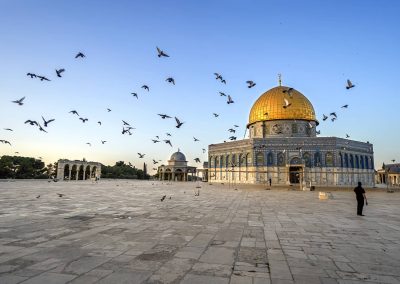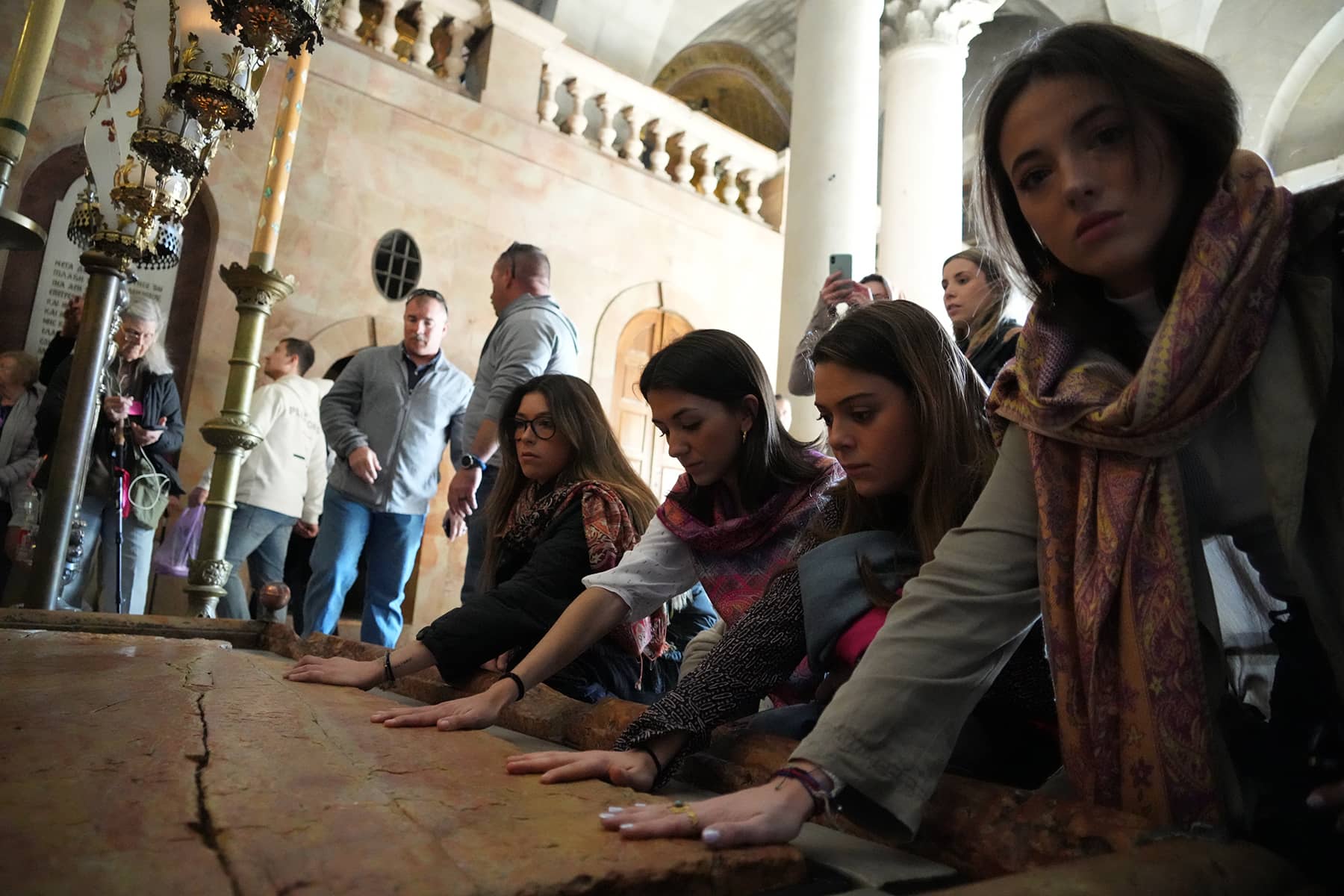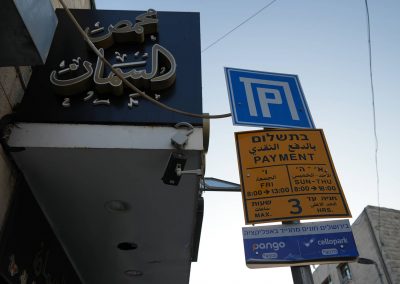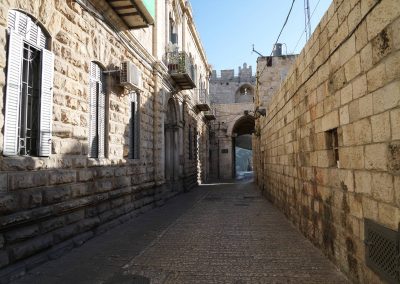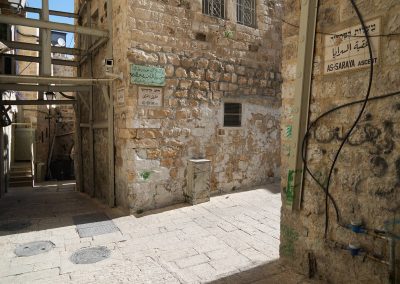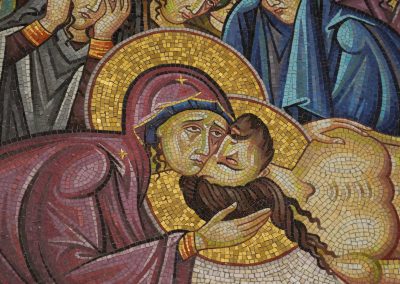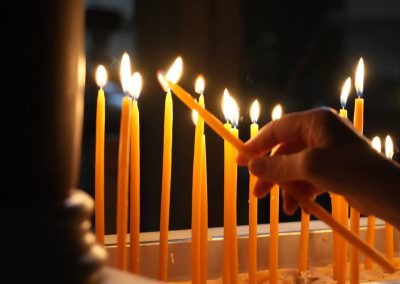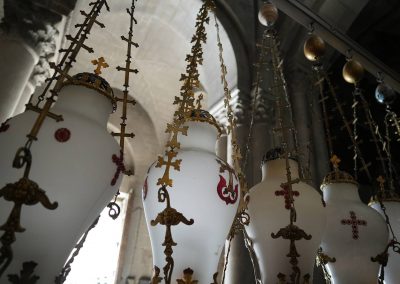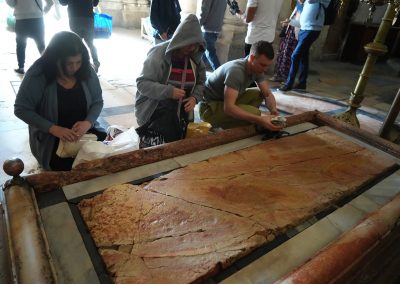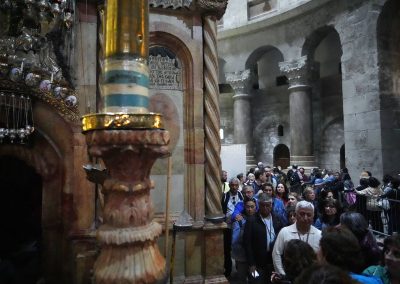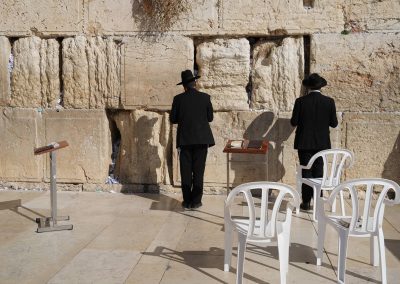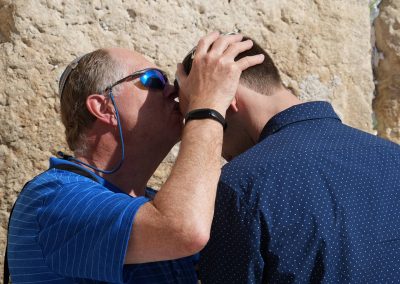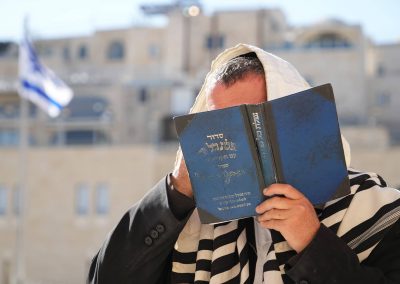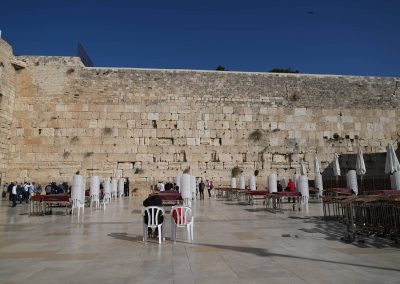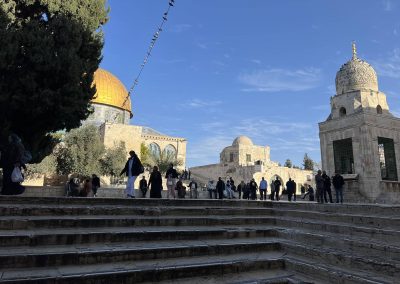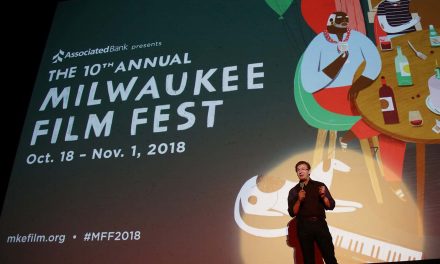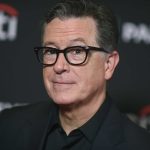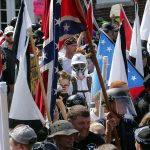
The ancient city of Jerusalem as has existed in my awareness for as long as I can remember. From stories of family pilgrimages, to historical lessons in school, to the nightly news, and basically every mention of it in religion. It is a place that inspires a journey to reach, but any expectation that I would ever travel there were abandoned long ago. So it was not without a little irony that I found myself walking the narrow streets of the Old City at the end of January.
I took on a photojournalism assignment to document a team of Syrian American doctors from Milwaukee and Chicago, as they traveled to Jordan for a mission with Syrian American Medical Society (SAMS) to provide free medical services to Syrian refugees. The mission was six days, but I arrived early to enjoy Amman, Jordan before everything began. Then I stayed a few extra days to join a group of physicians who planned a trip to Jerusalem after the medical mission concluded.
I had wanted to visit Jordan’s famous archaeological site of Petra, but the logistics to get there meant I could not visit Jerusalem if I did. I figured it would be my only opportunity to see the Holy Land.
The day we planned to leave for Jerusalem, I got a newsflash from the Associated Press about the deaths of several Palestinians. We were at a remote clinic when I got the alert, and the news was still not widely known. So I mentioned it, with concern about how it would affect our trip.
The initial reactions were of little concern, because Palestinians were always being killed by security forces. A very sad situation to be so commonplace. But later in the day, things had grown more urgent and the group debated about not going. There was a strong possibility that we could reach the border with the Holy Land only to be refused entry. It had already happened that morning, when a family member of a doctor was not allowed in for a visit.
At that point it seemed like I would get to visit Petra after all. Hearing all the concerns, I was ready to play it safe and give up on the idea of visiting Jerusalem. So it was kind of funny when one doctor asked the group in front of me, but as if I was not there, if I would be okay going to Jerusalem. To which another doctor answered, again as if I was not there, that he had been to the war in Ukraine, so he would be fine. My concerns about going did seem absurd in that context. And just like that the group decided to roll the dice and try to go.
The journey over land did remind me of the experience I had crossing from Poland into Ukraine last year. Not the most comfortable ride of soothing process, especially when racing against the clock to pass security obstacles.
Our group made it to passport control at the border just before they stopped letting people in. We waited to see if any of us would get through. At passport control, I answered the usual questions … why was I visiting, for how long, and such. The passport officer seemed to struggle with something at his desk – beneath my field of vision, and then he left his desk.
By that time I had been standing in line for a while, and my team – who were waiting in the entry area – thought I was in trouble. I had figured that some visa stamping machine was not working, so the immigration officer had to go to another desk. But I could not communicate that from a distance.
When the officer returned, I got my passport and entered the Holy Land about 20 minutes before the border closed. It felt like such an achievement after hours of uncertainty. I sent a GPS position of that moment from my Apple Watch to friends back in Milwaukee. I found out later, to my amusement, that their first reaction was I had let them know where I was because someone kidnapped me.
It would be a few more hours of driving to my hotel just outside of the Old City, and then a dinner of wonderful Palestinian food. Sorry, Pizza, you were my first choice but no one at the table thought it was appropriate.
The next day I was excited to explore the city with my group of friends. They had gotten up before sunrise to attend morning prayer, and I could hear the melodic call to prayer in the distance. But by the time I was ready to meet them, there were major complications.
Security forces were not letting any non-Muslims past the gates of the Dome on the Rock, the Qubbat aṣ-Ṣakhra. I was not going to pray, and usually I would be allowed into the Al-Aqsa Compound area. The public is even allowed inside the Mosque itself for tours but not in the prayer area.
But security forces had orders to not allowing any non-Muslims to enter. I was told repeatedly to come back later, and then gate after gate still refused to let me in. So I could not join my team who wanted to pray, and participate in activities within the compound. The entire time I was in Jerusalem I was not allowed to get close to the Dome of the Rock. It was a disappointment, and of course the more anyone tells you that you cannot do something the more you want to do it.
I did not look like a traditional Muslim, which made me rather easy to identify. On one attempt to enter I actually made it past the gate in a large crowd. After a few hundred feet thought I had finally succeeded, only to be asked to leave. A squad of security troops got yelled at for letting me slip by on my way out.
I had no trouble to enter the Western Wall. And at the Church of the Holy Sepulchre I saw Muslims and non-Muslims alike. Each of the three sites represented an icon of the World’s three main religions. I was visiting more for the history than for a pilgrimage of faith.
So that was pretty much how my experience went, trying to enjoy a Holy Land that felt like an occupied city. I met up with my physician friends when I could, otherwise I was left to explore on my own. I had not done any preparation for the visit, expecting to follow the others who would show me around.
The streets of the Old City felt like I was traveling through the passages of a cave, but with no roof. There was a layer upon another layer at every turn. It was fascinating to explore shops and visit more obscure Holy Sites.
I depended a lot of Google Maps to navigate the ancient maze. And I discovered a new feature that really helped. When I would reach a fork in the path, it was not always obvious which way was a turn and which was the way straight. But holding my iPhone up, the Google Map app would use the camera to scan for landmarks. Then it would display directional markers using augmented reality. That was really cool, but most importantly it was super helpful to determine which twist or turn I needed to take.
The app delivered me to the front door of the Church of the Holy Sepulchre. But because the entrance was so obscure among the street shops, I ended up walking around it to the other side, which did have more elaborate signage to welcome visitors.
It was a memorable experience to finally be inside. Just last year I had visited St. Sophia’s Cathedral in Kyiv during the war. I had felt very moved because of its history that dated back to 1018 AD. The Church of the Holy Sepulchre had opened in 335 AD. So my mind was even more overwhelmed at the thought of being just another small speck in human history to have walked across the site over its 1,700 year existance.
I was also fascinated to watch the expression of faith from people. I had been of the opinion that I did not need to travel to the Holy Land to improve my relationship with God. But since I was there, I still did what I considered to be the religious tourist stuff. I did it all so I would not have to explain why I traveled all that way and did not do it.
I touched what was meant to be touched, and prayed here and there, thinking it both interesting and awkward. I saw the room were apparently the body of Christ was prepared for burial. It was amazing to be standing at a place that was at the center of human history. But I was not spiritually moved, even though all around me it appeared that most all the other visitors were. More than a few times I wondered, what was wrong with me?
The only spiritual experience I had the whole time in Jerusalem came without invitation at the most unexpected place. I made my way to the Western Wall because of its Jewish significance, and my family heritage. I took photos and watched men pray at the wall. Again, I thought that I had traveled all that way, I should at least touch the wall and say a prayer.
With both hands I reached out, and what I felt when my fingers touched the stone is hard to articulate. It was not a shock of electricity, but a humbling energy. I found myself struggling to find the words in my mind to even say a simple prayer. I was overwhelmed.
I eventually stepped back and shook my head, as if to snap out of it. The Western Wall had no spiritual significance to me, but I had quite literally one of the most profound spiritual experiences there. I arrived doubtful, I left doubtful, but for a few minutes I had a wonderful and confusing and overwhelming spiritual encounter.
And then it was back to navigating the old streets, taking photos and looking for gifts to bring back home. For the trip, I brought my main camera, the Sony α1. But before leaving, instead of packing my backup camera, a Sony α9, I decided that I needed the room for packing other things. I had taken the α9 to Ukraine as a backup and never needed it. I was traveling only what I could fit into a backpack with under 30L of storage. Anything I took needed to support me for two weeks.
I ended up getting new Sony camera and my first premium compact camera, the Sony RX100 VII. After research and my own testing, I was pleased to find it delivered powerful images very near the quality of my pro level cameras.
I originally reasoned that if I was anywhere sensitive taking photos, my pro camera with its big lens might draw too much unwanted attention. If I used my iPhone and any security people wanted to stop me, they would take my iPhone – and with it my lifeline of communications. But if I used a pocket camera, having that taken would not leave me stranded. So it was also an expensive but expendable camera.
It turned out to be a great camera, and it was very handy in ways I did not originally predict. I could snap some thing that I would have missed trying to unpack my big camera. Also, as often as I could, I tried to look like a tourist. No one saw me as a photojournalist or took me seriously with the baby camera.
These photos reflect many of the adventures I had. No photo could capture the experience of moving against the tide of humanity as worshipers after prayer ended. I was a fish swimming up stream as they poured out of the areas I was trying to enter. The closest I ever came to that crush was in China at the airport.
Otherwise, these images are not groundbreaking in what they show. After a hundred years of being the most photographed place on earth, there was nothing new for me to document. But the experience was unique to me, with my Milwaukee background, and the images offer that hometown view to others considering their own visit.
Lee Matz
Supplemental images from Cunaplus, Hikrcn, Nick Brundle, RICIfoto, Meunierd, and Robert Hoetink were used in this photo essay to approximate sights that were seen, but that conditions did not allow to be photographed.


